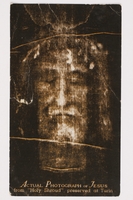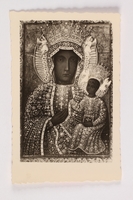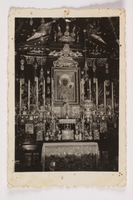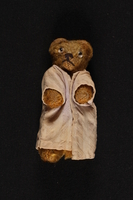Overview
- Brief Narrative
- The book was used by the donor as a student in the fourth grade in Busko-Zdrój, Poland; dated 1946-1947.
- Title
- Fairy tales
- Credit Line
- United States Holocaust Memorial Museum Collection, Gift of Sophie Turner-Zaretsky
Physical Details
- Classification
-
Books and Published Materials
- Category
-
Books and pamphlets
- Object Type
-
Books (lcsh)
- Materials
- overall : paper, ink
Rights & Restrictions
- Conditions on Access
- No restrictions on access
- Conditions on Use
- No restrictions on use
Keywords & Subjects
Administrative Notes
- Legal Status
- Permanent Collection
- Provenance
- The book was donated to the United States Holocaust Memorial Museum in 2002 by Dr. Sophie Turner-Zaretsky.
- Record last modified:
- 2023-04-06 09:13:05
- This page:
- https://collections.ushmm.org/search/catalog/irn520820
Download & Licensing
In-Person Research
- By Appointment
- Request 21 Days in Advance of Visit
- Plan a Research Visit
- Request to See This Object
Contact Us
Also in Sophie Turner-Zaretsky collection
The collection consists of objects, letters, documents, and publications relating to the experiences of Laura and Selma (Zofia) Schwarzwald in Lvov and other areas of Poland where they lived in hiding under assumed indentites as Catholics during and after the Holocaust. Some of these materials may be combined into a single collection in the future.
Date: 1901-1950

Our Lady of Czestochowa holy card received by a young Jewish girl living in hiding as a Catholic in Poland
Object
Holy card acquired by 6 year old Selma Scharzwald in May 1943 when she was living in hiding with her mother as a Polish Catholic under the name Zofia Tymejko. She received the card during a trip to Czestochowa, Poland, when she visited the church at Jasna Góra (Klasztor Paulinów). The trip was organized by her mother's employer, the Regional Agricultural Cooperative in Busko Zdroj. Zofia and her mother, Laura, escaped from the ghetto in German occupied Lvov, Poland (Lviv, Ukraine) after her father was shot by the Gestapo in 1942. They adopted false identities as Catholics and lived briefly in Krakow, then moved to Busko Zdroj. Selma attended Catholic school and had her First Communion after the city was liberated by the Soviet Army in January 1945. They emigrated to England in 1948 after there were violent anti-Jewish riots in the area. That was when Zofia learned that she was Jewish; news that shocked her after her upbringing in an antisemitic environment where she had been taught to hate Jews.

Our Lady of Czestochowa holy card received by a young Jewish girl living in hiding as a Catholic in Poland
Object
Holy card acquired by 6 year old Selma Scharzwald in May 1943 when she was living in hiding with her mother as a Polish Catholic under the name Zofia Tymejko. She received the card during a trip to Czestochowa, Poland, when she visited the church at Jasna Góra (Klasztor Paulinów). The trip was organized by her mother's employer, the Regional Agricultural Cooperative in Busko Zdroj. Zofia and her mother, Laura, escaped from the ghetto in German occupied Lvov, Poland (Lviv, Ukraine) after her father was shot by the Gestapo in 1942. They adopted false identities as Catholics and lived briefly in Krakow, then moved to Busko Zdroj. Selma attended Catholic school and had her First Communion after the city was liberated by the Soviet Army in January 1945. They emigrated to England in 1948 after there were violent anti-Jewish riots in the area. That was when Zofia learned that she was Jewish; news that shocked her after her upbringing in an antisemitic environment where she had been taught to hate Jews.

Our Lady of Czestochowa holy card received by a young Jewish girl living in hiding as a Catholic in Poland
Object
Holy card acquired by 6 year old Zofia (Selma) Scharzwald in May 1943 when she was living in hiding with her mother as a Polish Catholic under the name Zofia Tymejko. She received the card during a trip to Czestochowa, Poland, when she visited the church at Jasna Góra (Klasztor Paulinów). The trip was organized by her mother's employer, the Regional Agricultural Cooperative in Busko Zdroj. Zofia and her mother, Laura, escaped from the ghetto in German occupied Lvov, Poland (Lviv, Ukraine) after her father was shot by the Gestapo in 1942. They adopted false identities as Catholics and lived briefly in Krakow, then moved to Busko Zdroj. Selma attended Catholic school and had her First Communion after the city was liberated by the Soviet Army in January 1945. They emigrated to England in 1948 after there were violent anti-Jewish riots in the area. That was when Zofia learned that she was Jewish; news that shocked her after her upbringing in an antisemitic environment where she had been taught to hate Jews.

Refugee, a honey brown teddy bear with a pink robe, owned by a young Jewish girl who had lived in hiding as a Catholic
Object
Small, golden teddy bear named Refugee received by eight year old Zofia (Selma) Scharzwald from her mother as a birthday or Christmas present after the war ended in May 1945. Her aunt crocheted a coat for it. Zofia named it Refugee because she thought its uneven eyes made it look " a little down and out." Zofia and her mother, Laura, escaped from the ghetto in German occupied Lvov, Poland (Lviv, Ukraine) after her father was shot by the Gestapo in 1942. They adopted false identities as Catholics and lived briefly in Krakow, then moved to Busko Zdroj. Selma attended Catholic school and had her First Communion after the city was liberated by the Soviet Army in January 1945. They emigrated to England in 1948 after there were violent anti-Jewish riots in the area. That was when Zofia learned that she was Jewish; news that shocked her after her upbringing in an antisemitic environment where she had been taught to hate Jews. In December 2006, a replica of Refugee was taken on a mission of the space Shuttle, Discovery, by Commander Mark Polansky. Each astronaut is invited to take a few items and Polansky took Refugee and a contemporary photograph of a child refugee from Darfur.
Sophie Turner-Zaretsky papers
Document
The papers consist of 47 photographs of Selma Schwarzwald (now Sophie Turner-Zaretsky, donor) and her family before and during the Holocaust, a group of school notebooks and books used by the donor in hiding, certificates issued to the donor's mother in her false name, correspondence written by the donor's mother and the donor between 1935 and 1950, correspondence written by the donor's maternal uncle who died in Palestine, an autograph album, and various other documents.
Book
Object
The book was given to the donor as a prize for outstanding results at athe end of the school year in Busko-Zdrój, Poland; dated June 30, 1947.
Nad dalekim, cichym fiordem [Book]
Object
The book was given to the donor by her school friend, Basia Knap, in Busko-Zdrój, Poland; signed, "Zofia Tymejko" and dated Jan. 28, 1948.
Dr. Sophie Turner-Zaretsky papers
Document
Contains two postcards and three letters, all handwritten, addressed to Adela Litwak (Ksenia Osoba), the donor's maternal aunt, by two people: Fryda Litwak (Zofia Wolinska), who was in a forced labor camp in Germany; and Zosia Tymejko (the donor's name while in hiding), in Busko-Zdroj, Poland.
Diploma
Document
School diploma, printed form in black ink, with handwritten sections in blue ink, from St. John's Wood Synagogue school in London, issued to the donor.
Dr. Sophie Turner-Zaretsky papers
Document
Collection consists of documents relating to Laura Turner (the donor's mother), who attended different educational institutions to establish herself in England after surviving the Holocaust in the Lvov ghetto and later in hiding. Includes a document issued to Xenia Osoba (real name Adela Litwak; donor's maternal aunt), stating that she is a Pole and is on her way to Warsaw; dated September 5, 1942 in Lvov; in German.



